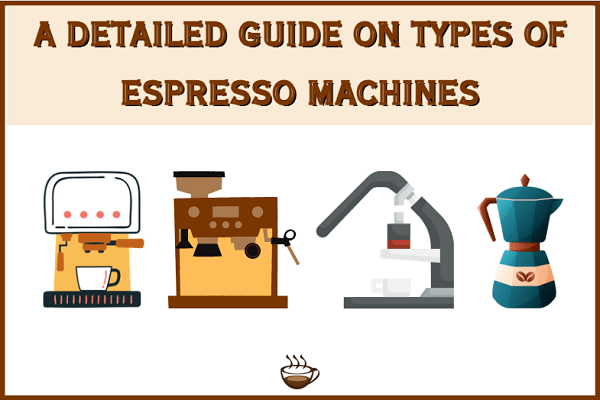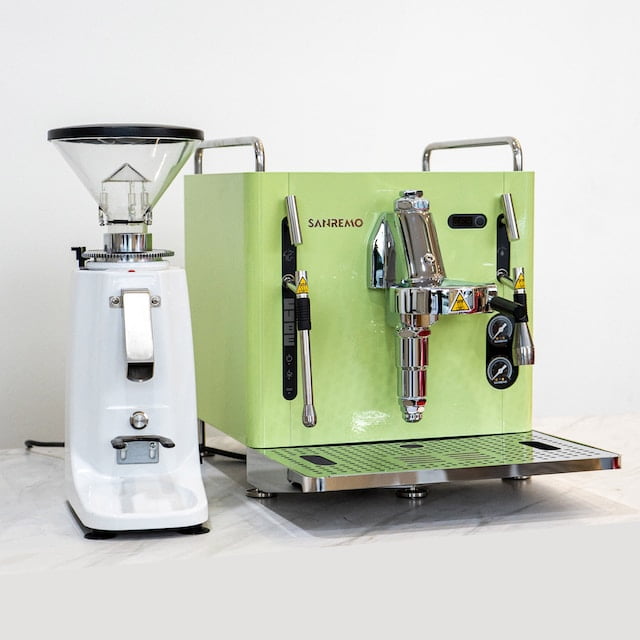There are many different types of espresso machines available. From simple and inexpensive models to more high end and costly units, from small and portable machines to large, bulky industrial machines, and from fully manually operated machines to super-automatic ones.
For espresso aficionados, no ordinary drip coffee maker can recreate the thick, concentrated bliss of a freshly pulled shot.
But with so many options, choosing the right espresso machine for your needs can be overwhelming.
In this guide I will discuss 15 different types of Espresso machines available, giving you a brief overview of each type and discussing their pros and cons so you easily what’s right for you.

An Overview of Espresso machines
An espresso machine is a sophisticated piece of equipment that forces hot water through finely ground coffee beans at a high pressure of 9 bars, extracting the flavor and aroma to produce a thick and intense small shot of coffee.
You can either consume these intense shots of coffee as is or turn them into other fancy espresso drinks like Cappuccino, Latte, or Americano to name a few.
As espresso machines operate at high pressure, so their design must be sturdy, and that’s why espresso machines are more expensive than regular coffee makers.
Espresso machines come in a variety of sizes and price ranges, making it possible for coffee lovers to find one that suits their needs and budget.
With the right espresso machine, anyone can create a delicious shot of espresso and enjoy a rich, full-bodied coffee experience.

7 Different types of Home Espresso machines
There are three main types of Espresso machines, semi-automatic, automatic and the super automatic, and then there are manual, pod based, stovetop, and portable Espresso machines.
Let’s discuss each type in detail:
1. Semi-automatic Espresso Machine
Semi-automatic espresso machines give more control over the brewing process. They are popular among coffee lovers who want the ability to customize their espresso shots.
Using these machines, you grind coffee beans (some of them come with a built-in grinder), fill the portafilter with ground coffee, and tamp it to make sure it is even. After that, you’ll attach the portafilter to the brew head and start the machine to force water through the coffee grounds into the cup and stop the machine when the desired volume is achieved.
Semi-automatic espresso machines typically have features such as a steam wand for frothing milk and a control panel to adjust the water temperature and pump pressure.
Some of the top brands of semi-automatic Espresso machines include Breville, De’Longhi, and Gaggia. These machines cost around 200 to 1000 dollars depending on features.
These machines are perfect for folks who want to level up their Barista skills and want customizable drinks.

Pros
✔️ Give users complete control over the grind size, tamping, dose, and yield.
✔️ Brews the best shot possible if the user knows how to do it.
✔️ Affordable price
✔️ Often have built-in stem wand and coffee bean grinder
Cons
❌ There’s a lot of manual work involved which some users might hate
❌ Requires the knowledge of brewing process – So it ain’t beginner-friendly
2. Automatic Espresso Machine
An automatic espresso machine does a lot of work for you. All you have to do is grind your beans and put them in the machine.
You do not need to manually control the water flow or the extraction time as in the case of a semi-automatic Espresso machine; the machine handles that by itself.
These machines typically feature built-in grinders, water reservoirs, and milk frothers, and have programmable settings to prepare different espresso-based drinks, like cappuccino, latte, and more.
Some models also feature touchscreen displays and other advanced features, such as automatic cleaning cycles and self-diagnostic systems, to make them even more user-friendly.
These machines cost around 1000 to 2000 dollars depending on the features they offer.
Automatic Espresso machines are perfect for beginners and regular home users.

Pros
✔️ Have a quick brew time
✔️ Requires little to no effort
✔️ Easy to use
✔️ Delivers a consistent shot of Espresso every time
Cons
❌ Not a budget-friendly option
❌ You don’t have control over the extraction time and yield.
3. Super Automatic Espresso Machine
Super-automatic espresso machines are high-end devices that are easiest to use. These machines are even more automated than automatic espresso machines and typically have a range of built-in features that can grind, dose, tamp, brew, and froth milk automatically, without the need for any manual intervention.
Super-automatic machines typically feature programmable settings that allow users to customize the strength, volume, and temperature of their coffee drinks.
However, the increased automation also means that there is less room for experimentation and customization, as the machine handles most of the brewing process.
These machines are ideal for busy individuals who prefer a hassle-free brewing experience without doing any work!

Pros
✔️ Offer all-in-one systems
✔️ You can prepare Latte and Cappuccino at the touch of a single button
✔️ No brewing expertise is required
✔️ Always deliver consistent results
Cons
❌ Not a budget-friendly option
❌ You have absolutely no control over the brewing process – You can only alter pre-set settings at most.
4. Lever Espresso Machine
In lever espresso machines, you have to manually pull a lever to generate the pressure for extracting espresso from ground coffee.
Unlike traditional espresso machines that use an electric pump to create pressure, a lever espresso machine relies on the operator’s strength and skill to pull a perfect shot.
Lever espresso machines require experience to operate effectively, and many coffee enthusiasts prefer them because they offer greater control over the extraction process and can produce a more nuanced and flavorful shot of espresso.
These machines are only recommended for experts.

Pros
✔️ Produce a distinct flavor profile
✔️ Lightweight – Can be a perfect travel partner
✔️ Allows you to prepare a completely customizable shot
Cons
❌ Needs more effort and physical work
❌ Certainly not a beginner-friendly option.
5. Pod-Based Espresso Machine
Pod-based espresso machines work with pre-measured capsules filled with coffee grounds.
These pods are designed to be disposable and contain a tightly packed amount of coffee that is punctured by the machine, allowing hot water to pass through and extract the espresso shot.
The main benefit of pod-based espresso machines is their convenience and ease of use. Insert the pod, Push the brew button, and your shot will be ready in minutes. As simple as it is!
Nespresso is the top brand in the pod-based espresso machine industry.
These machines are perfect for office use and busy folks.

Read a guide on Is Nespresso worth it
Pros
✔️ Gives quick, neat, and consistent results
✔️ Extremely user-friendly – Even a 3-year-old can brew espresso shots using it
✔️ Compact and exquisite design
Cons
❌ You have to compromise a little on taste
❌ Pods are more expensive than ground coffee
❌ There’s no room for customization
Also Read: Espresso Machines vs Nespresso
6. Stovetop Espresso Machine
A stovetop also known as a Moka pot is a coffee brewing device that is designed to produce espresso-like coffee on a stovetop.
In stovetop espresso makers, the bottom chamber is filled with water, and the middle chamber is filled with ground coffee. The device is then placed on a stovetop, where the heat creates steam and forces hot water through the ground coffee into the top chamber, where the brewed coffee collects.
Note that these devices use only steam pressure which is around 2 bars while the pressure required for real Espresso is 9 bars. So we can say that Moka pot can’t classify as a real Espresso maker.
But it’s a great option for those who looking for a beginner a budget-friendly option to brew rich and strong coffee.

Pros
✔️ Budget-friendly option – Available for less than 50 dollars
✔️ Can brew multiple cups at a time
✔️ Prepare rich and strong coffee
Cons
❌ Can’t classify as a real Espresso
❌ Can make burnt or bitter coffee when not used properly.
Also Read: Moka Pot vs Espresso machines
7. Portable Espresso Machines
Portable espresso makers are compact, lightweight devices designed to produce espresso on the go.
They are perfect for people who love espresso but want the convenience of being able to brew it anywhere, anytime, without the need for electricity or bulky equipment.
One thing to note is that while portable espresso makers can produce a decent shot of espresso, the quality may not be as high as that produced by a traditional or lever espresso machine.

Pros
✔️ Best option for hikers, campers, and travelers.
✔️ Lightweight and easy to use
✔️ Affordable option – under 100 dollars
Cons
❌ Certainly can’t produce the best espresso shots
❌ Time-consuming manual operation
❌ Can only prepare 1 or 2 shots at a time
Also Read: Best Portable Espresso Machines
Variation of Espresso Machines Based on Working Mechanism
8. Steam Espresso Machines
Steam Espresso machines work by heating water in a reservoir to produce steam, which is then used to force hot water through the espresso grounds and extract the flavor and aroma of the coffee.
These were the Earliest models of Espresso machines.
In a steam Espresso machine, the amount of pressure generated is hardly 2 to 3 bars so technically it can’t be classified as real espresso.
Steam espresso machines can be a good option for people who want to make espresso at home without spending a lot of money on an expensive machine or who don’t require the same level of precision and consistency as a professional espresso maker.
These machines are easily available for under 100 dollars.

Pros
✔️ More affordable and budget-friendly.
✔️ Compact design
✔️ Easy to use and maintain
Cons
❌ Can’t generate the required pressure of 9 bars
❌ They often produce burnt or bitter shots when not used properly
9. Piston Espresso Machines
A piston-driven espresso machine uses a manual lever to generate pressure and extract espresso.
Piston-driven espresso machines are often used by coffee purists who prefer the hands-on control they provide and the traditional espresso-making process.
However, they do require some skill and practice to use effectively, and they may not be as efficient or consistent as pump-driven machines.
Pros
✔️ Can prepare Best tasting shots when used properly
✔️ No electricity is needed
✔️ Quiet operation
Cons
❌ Requires more expertise and physical effort to pull a shot
❌ Achieving consistent results with a piston-driven machine can be challenging
10. Pump Espresso Machines
Pump-driven machines are the most common type of espresso machine found in commercial settings and home kitchens.
These machines use an electric pump to force hot water through the coffee grounds and extract espresso.
These machines pull Espresso shots consistently at a high pressure of 9 bars.

Pros
✔️ Generates high pressure of 9 to 15 bars
✔️ Always prepare consistent shots
✔️ These machines are easy to use
Cons
❌ These machines are expensive
❌ Have a heavy design
Variations of Espresso Machines Based On Heating Mechanism
There are three different types of Espresso machines based on the heating mechanism.
11. Single Boiler Espresso Machines
A single-boiler espresso machine is a type of espresso machine that has one boiler to heat the water for both steaming milk and extracting espresso.
The single boiler is designed to switch between two different temperatures, one for brewing espresso and another for steaming milk.
You can’t brew espresso and steam milk in these machines simultaneously. So, preparing a single serving of latte or cappuccino requires a lot of time.
Single-boiler espresso machines are a good option for home users who do not require high volume and want a lower-cost option.

Pros
✔️ Budget-friendly option
✔️ Compact and sleek design
✔️ Can prepare good-tasting shots of Espresso
Cons
❌ Takes time to brew
❌ Not a good option for busy people and commercial use
12. Double Boiler Espresso Machines
A dual boiler espresso machine is a type of espresso machine that has two separate boilers – one for steaming milk and another for brewing espresso.
The two boilers are designed to operate independently, allowing the user to brew espresso and steam milk simultaneously.
With a dual-boiler espresso machine, you can set the temperature for each boiler independently. This makes the brewing process faster and more efficient, which is ideal for high-volume environments such as coffee shops.
Dual boiler espresso machines are suitable for both commercial and home use, particularly for coffee enthusiasts who are willing to invest in a high-quality machine that offers greater control and flexibility in the brewing process.

Pros
✔️ Can brew and steam milk simultaneously
✔️ Perfect option for Baristas and home coffee experts
✔️ Can prepare good-tasting shots of Espresso and Lattes
Cons
❌ Expensive option
❌ Heavy and bulky design
13. Heat Exchanger Espresso Machines
These types of espresso machines use a heat exchanger to heat the water for both brewing and steaming.
Unlike single boiler machines, which can only perform one task at a time, a heat exchanger machine can brew espresso and steam milk simultaneously without any waiting time.
One potential drawback of heat exchanger espresso machines is that the temperature of the water used for brewing cannot be controlled as precisely as with a dual boiler machine.
However, this isn’t a big concern for the regular home user as it doesn’t matter a lot.

Pros
✔️ Affordable than a double-boiling espresso machine
✔️ No cooling time between shots
✔️ Can prepare good-tasting shots of Espresso and Lattes
Cons
❌ Lacks the ability for precise temperature adjustment
❌ The shots may get inconsistent sometimes
Variations of Espresso Machines Based On Water System
There are two types of Espresso machines based on the water system.
14. Plumbed Espresso Machines
A plumbed espresso machine is a type of direct-connect espresso machine that is designed to be connected to a permanent water supply.
These machines have a constant water supply, so you’ll never have to worry about filling the water container.
A plumbed espresso machine is a good choice for commercial settings where a constant supply of water is necessary.

Pros
✔️ Never-ending water supply
✔️ Perfect for commercial use
✔️ Can prepare good-tasting shots of Espresso and Lattes
Cons
❌ Expensive and difficult to install
❌ Not perfect for home users as it can’t be relocated
15. Pour Over Espresso Machines
This espresso machine has a tank that holds the limited amount of water required to brew espresso, so you’ll need to fill it again when it gets low.
These machines are more common in home settings, as they do not require a dedicated water line.

Pros
✔️ Simple and easy to set up
✔️ Easy to relocate
✔️ Needs fewer maintenance
Cons
❌ The constant demand for refills
What are the different parts of the Espresso Machine?
Here are some of the typical parts of an espresso machine.

Group Head: The component where the portafilter attaches, allowing hot water to flow through the coffee grounds.
Portafilter: The handle-like device with a basket that attaches to the group head of the machine for brewing espresso.
Filter basket: Removable basket inside portafilter that holds coffee dose.
Tamper: Tool used to compress and flatten the surface of ground coffee in the filter basket.
Steam wand: A metal arm that froths and steams milk for making lattes and cappuccinos.
Brewing Control Button: Found in Automatic and Super Automatic Espresso machines for pre-programmed Espresso shots and Lattes.
Grinder: Grind the fresh whole-bean coffee to fine settings.
Boiler: Heats and maintains the water temperature for brewing espresso and steaming milk
Drip Tray: Catches any spills and excess water, keeping your countertop clean
Cup Warmer: A heated surface on top of the machine to keep espresso cups warm before serving.
Water Reservoir: Stores the water supply for brewing, typically removable for easy refilling.
Pump: Generates water pressure of 9-15 bars for espresso brewing.
Top Brands of Espresso Machines
Breville: Australian brand Known for their precision and innovation, Breville espresso machines offer a wide range of features, from beginner-friendly options to professional-grade equipment.
De’Longhi: Leading Italian brand offering a wide range of affordable, easy-to-use home pump espresso machines.
Gaggia: Gaggia is known for its classic and durable espresso machines, offering traditional Italian espresso brewing methods alongside modern features.
Jura: Swiss pioneer in super-automatic machines, making them a top choice for those who want espresso at the push of a button.
Rancilio: Commercial-grade Italian manufacturer trusted by cafes for extremely durable, barista-quality machines.
La Pavoni: La Pavoni specializes in manual lever espresso machines, appealing to purists who appreciate the hands-on espresso-making process.
Final thoughts
To conclude, espresso is a delightful drink, but only when made with high-quality equipment that matches how your coffee appears and tastes. It is up to you to pick what type of espresso machine you want because different types have different perks and drawbacks.
I hope this article has helped you in understanding the different types of Espresso Machines. Whether you’re a home user or a professional barista, there is an espresso machine out there to suit your needs and preferences.
I love and own semi-automatic machine as they are customizable and enable me to prepare a wide range of espresso drinks. I enjoy the level of control that the machine offers, from adjusting the dose and grind size to the tamp pressure and extraction time. With just a few tweaks, I can create a perfect shot of espresso every time.
Also Check Out:
FAQs
How much does an espresso machine cost?
The cost of an espresso machine can vary widely depending on the type of machine, its features, and its quality. A typical home espresso machine costs between $250 and $800, whereas an average commercial espresso machine costs more than $3000.
What is the pressure Espresso machines should generate for a perfect shot?
The ideal pressure for an espresso machine to produce a perfect shot of espresso is between 9 and 10 bars. This pressure is required to extract the full flavor and aroma from the coffee beans while creating the characteristic crema on top of the shot.



